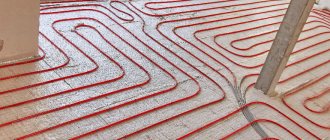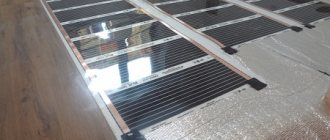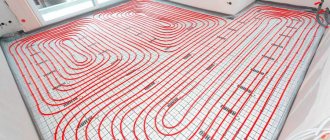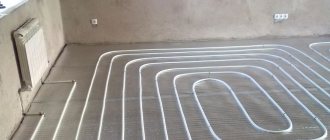Finding a pipeline leak in an apartment
Often, builders, when carrying out renovations in apartments, houses and cottages, wall up water supply, heating and sewage pipes into walls or floors.
Thanks to this, it is possible to improve the appearance of the room, but a problem may arise - in the event of a water leak, you have to dismantle the entire masonry. Usually no one thinks about this during repairs, relying on the Russian “maybe”, but then you have to regret the decision. We all understand that hidden communications are the absolute norm. But only if the engineering lines are of a modern type made of cross-linked polyethylene, for example Rehau or Uponor. However, the principle of operation during installation, even with such engineering in our country, by Kulibin and mountain plumbers, still remains at the level of metal-plastic ten years ago. Mainly for these reasons, water leaks occur during operation, which lead to floods.
Video 1. Finding a hidden leak in the wall with a thermal imager.
Finding leaks in the wall/floor
We will find a leak in a wall or floor without dismantling the finish thanks to a set of professional equipment
How to find a leak in the wall?
You can tell that there is a leak in the wall by the following signs:
- wet spots
- damp walls
- bloated wallpaper
- peeling putty
- fungus or mold
Very often, traces of leaks are hidden by tiles or waterproof wallpaper, so a lot of time passes from the moment the leak starts until it is detected. A small stain may indicate a serious problem. It’s better not to delay and immediately find out how to find a leak in the wall.
Disassembling tiles, tiles, and wallpaper is not an option. We offer a non-contact way to localize the problem, and we know how to find a leak in a pipe without dismantling it. Our secret is in choosing not just one device, but a whole complex.
Prices for leak detection
| In the wall, screed | from 4,000 rub. |
| In a warm floor | from 4,000 rub. |
| In the heating system | from 4,000 rub. |
| Opening | from 3,000 rub. |
| Repair | from 3,000 rub. |
| 30 rub/km | Travel outside the Moscow Ring Road |
All leakage cases are individual. Call for pricing and consultation.
Examples of leaks we have found
- in a residential building
- heated floor
- heating pipes
- DHW
- Violation of waterproofing
- HVS
- Sewers
- heating
Heating leak in the facade
A severe heating pipe leak was detected. The depth of the pipes is 0.6 meters below the ceiling level. Found from the front of the house.
Heated floor leak
An autopsy of the site made it possible to understand the reason. At the time of pouring the screed, the pipes were repeatedly damaged by shovels.
Leaking heating pipes
The customer complained about a drop in pressure in the boiler and a leak from the second floor. We used a thermal imager to find the location of the leak. An autopsy indicated mechanical damage.
Hot water leak
The exact location of the defect has been identified.
Violation of waterproofing
The waterproofing of the balcony is damaged; the wall is wet. An opening of the site confirmed a violation of waterproofing technology.
Cold water leak
The leaks were invisible to the eye, but moisture was already appearing on the walls. Without our intervention, the leak would have ruined the finish.
Sewer leak
Detected using an endoscope.
Leak in heated floor
A temperature anomaly caused by a leak has been detected. They gave recommendations for inspection and repair of leaks.
Heating leak
A temperature anomaly was detected, suggesting the location of the leak. Disassembly confirmed the assumption.
Consequences of leaks
Examples of destruction caused by untimely elimination of leaks - from the practice of msk-poisk.
How to find a water leak in a wall using an integrated approach
Today, only our company uses such a wide range of professional equipment!
Each device corresponds to the state register of measuring instruments of Russia.
How to find a leak in your heating system
Finding a heating leak is a tricky task. The difficulty is that the pipes are hidden under concrete, tiles, and screeds. And when asked how to find a leak in a heating system, experts advise using a pressure gauge. You need to check the pressure in the boiler and tank, let the coolant cool, pump up the pressure manually, isolate each element of the system (floor, floor, room), and check it separately. But even so, it will be possible to find a water leak in the heating with precision down to the contour, and then to localize the leak you will have to remove the tiles or drill holes in the joints.
We offer a more effective way to find a leak in your heating system.
How to find a water leak? Why are hidden leaks dangerous?
Causes of water leakage
Quite often, many people do not decide to replace old water pipes, based on the fact that the upcoming work will be quite expensive and quite difficult to carry out. Others rely only on their own experience and try to replace damaged pipes on their own. But such work may not always be crowned with success. Basically, the process of replacing water pipes requires the use of specialized tools, as well as work experience.
Old water pipes, which have served for decades without proper repair, in most cases become clogged with rust, slag and other deposits. Inside the pipe there is only a small gap through which the flow of water passes, as a result of which the pressure in the pipe decreases.
There is also another problem associated with the appearance of rust on old pipes. Subsequently, holes are formed from which water begins to flow. In such places, the pipe wall becomes quite thin and, unable to withstand the pressure of water, bursts. These places are quite dangerous and extremely vulnerable. Such pipes can burst at any moment and flood your apartment, and with it your neighbors.
It is also possible that pipes can burst after the water in the systems freezes, and you will only be able to detect such breaks in the spring, when the weather outside is relatively warm. In this case, ice forms first on the walls of the pipe, and then grows along the radius until the pipe is completely covered with an ice plug. The formation of such a plug leads to a rapid increase in pressure in the pipe, causing it to burst.
It is worth noting that hot water pipes rupture more often due to a sharp temperature change in the main line.
Threats of water leaks
Such unexpected leaks and breaks in water pipes lead to:
- damage to your property;
- and can significantly affect your family budget.
The most dangerous of these factors for human health is the occurrence of mold. By spending a lot of time in rooms with high dampness, each of you risks your health.
The human condition is adversely affected by pathogenic spores of mold and fungus, which “feel” well in high humidity. As a rule, the foci of such bacteria are based in places with high humidity, respectively, also near places of pipe leakage. The spores enter the human body through the respiratory tract, being absorbed into the blood. Next, they destroy beneficial bacteria and suppress the immune system.
In addition, mold also literally “eats” building materials and affects their quality. Thus, you will need to not only take care of solving problems related to your health, but also carry out repairs in this room, as well as think about replacing the pipeline, if this is what caused the emergence of pathogenic bacteria.
Dealing with mold is quite difficult - both at the level of treating your health and at the level of the repairs done. No medicine can help you in this case until you eliminate the cause of mold and mildew. In this case, you will need to correctly determine the cause of the appearance of pockets of pathogenic bacteria and eliminate it.
There are special products that help in the fight against mold and mildew, but finding a universal solution is quite difficult. Without actually trying several products, you will not be able to determine the most suitable option for you. The best solution in this case would be to periodically diagnose the water supply system for hidden leaks and timely correct any problems that arise in its operation.
Special attention should be paid to the destruction of the foundation and brickwork in houses (sometimes this also happens in apartments). Hidden leaks in this case symbolize those holes, corrosion or cracks that form in the pipeline. In this case, the water does not immediately come out, but travels underground, washing its way up to several tens of meters in some cases.
Thus, water enters the brick or concrete (depending on what material the house is built from), saturates it, and when the ambient temperatures reach sub-zero temperatures, it freezes and then tears the material from the inside. It is worth noting that wet materials also release heat faster, i.e. wet walls in the house will be colder than dry ones.
How to Find a Hidden Leak
Sometimes such leaks practically do not manifest themselves and are invisible to the human eye. They can be determined by indirect signs, such as a drop in pressure in the boiler or wetness of any sections of the wall or ceiling. At first glance, this may seem like a fairly simple problem, but it will last until the leak manifests itself 100%. As noted earlier, pipe leaks are dangerous due to subsidence or complete destruction of the foundation due to soil erosion.
Finding water leaks should be done using specialized equipment. But in some cases you can do without a complex tool. The initial inspection at objects with suspected leaks is carried out visually, inspecting problem areas. Small or hidden leaks can be difficult to visualize. An initial inspection of problems can only be performed in case of severe leaks.
Inspection of heating and water supply systems with a thermal imager. Search for hidden leaks.
Many owners of their own homes are faced with the problem of finding hidden communications, leaks in the heating and water supply system or underfloor heating pipes. The need to identify the correct location of hidden pipe lines or underfloor heating arises when checking new systems, to simplify repairs, or before installing other equipment. The problem is that for the last 20 years, during construction and renovation, the customer did not want to see the pipes and the builders hid them in floor and wall screeds. This has led to the fact that, due to a violation of the technology for laying these routes or the use of low-quality materials, the owner of the house has serious problems in the form of water oozing out of nowhere (in the floor, walls, ceilings). What could be the causes of leaks in the house?
1. Tracing (visualization) of underfloor heating pipes and heating system wiring.
Carrying out repair work is a complex process and includes many nuances. In order to make quality repairs and at the same time not destroy what is already there, you have to take some precautions - for example, take care to find communications in the floor or wall. Very often it is necessary to determine the exact layout of the heated floor branches, otherwise you risk damaging the entire system, therefore, before carrying out repairs, you need to find all hidden pipes. For this purpose, thermal imaging tracing is carried out - recording the actual location of thermal plumes (routes) of hidden pipelines in the inspection areas.
communication tracing thermograms (click on the image to enlarge):
Heated floor pipes
Hidden pipe routing
Heating radiators
2. Search and registration of hidden areas of moisture in building structures.
In houses with autonomous heating, pressure gauges are installed and therefore it is possible to indirectly determine the fact of a leak by the pressure drop in the system. If the pressure in the boiler drops, this is the primary sign of a leak. To localize the leakage zone (moistening of materials), it is necessary to conduct thermal imaging diagnostics of the system. We use a combined leak localization method (high-precision thermal imager + pulsed humidity scanner). At the moment, this inspection method is the most accurate and gives the probability of localizing a leak up to 80%. Thermal imaging is one of the most effective tools for detecting problem areas, making invisible wet areas visible to the human eye. The accuracy of localizing the location of a hidden leak is from 0.5 m2 and depends on the design features of pipe laying, the type and thickness of the screed, and the use of heat-insulating materials on the pipes. A separate defect map is created for each surveyed area (click on the photo below). The cost of a thermal imaging survey depends on the area being surveyed.
Examples of recording leaks in cold water supply systems:
Examples of recording leaks in heating and hot water supply systems:
If necessary, areas localized by a thermal imager are examined using a pulsed moisture scanner, with the ability to detect moisture accumulation in porous insulating materials at a depth of up to 10 cm, and in concrete up to 5 cm.
FULL SERVICE CATALOG
Devices for detecting water leaks in walls
Thermal imager
A thermal imager sees the temperature distribution on the surface of an object. Due to the fact that the moisture inside the wall differs in temperature from the other surface of the wall, it can be detected. This is one of the easiest and fastest ways to identify a water leak . But it doesn't always work. The water may have insufficient temperature, be at depth, or there may be no visual access to the area under study.
Moisture meter
Another water leak detection device that determines the humidity level inside the wall. It is applied to various sections of the wall along the highway and identifies those places where the humidity level exceeds the norm. Separately, this device is ineffective. Since it takes a lot of time to find a leak, you need to gradually go through the entire line. And perhaps several times. It is most advisable to use it in conjunction with a thermal imager: the thermal imager finds suspicious areas, and you can use a moisture meter to check your assumptions.
Acoustic device
This is a kind of analogue of a phonendoscope - a medical device for listening to the lungs. It consists of headphones and a special sensor, which is also applied to the surface of the wall along the line and allows you to “hear” those areas where water is leaking. Such a good quality device is very expensive, and its cheaper analogues are not always able to detect leaks.
In practice, a thermal imager + moisture meter combination will be enough to detect most water leaks in pipes.
Leak detection equipment
Our specialists use the most productive methods and solutions when examining and searching for water leaks of any complexity. The extensive experience of our experts allows us to examine and identify pipe breaks in any conditions, and based on the diagnostic results, issue a report and draw up a conclusion about the leak for a positive resolution of the issue, including legal proceedings.
Video 3. Finding a hidden leak in a pipe using an acoustic leak detector.
In practice, we use exclusively innovative detectors to determine leaks in pipes and communications, which allows us to always achieve positive results.
It is used to study the distribution of thermal fields on the surfaces being examined.
Cost: 800,000 rub.
Used to search for leaks in domestic and drinking water supply pipelines.
It is used to determine the presence of moisture at the base of the building envelope at a depth of up to 10 cm.
Used to search and detect hidden utility lines.
Source
Leak in an apartment building
If a leak occurs in one of the sections of the highway, residents should contact the management company for help. As part of the surgical intervention, they can perform several simple steps:
- Shut off the heating riser. Other residents of the apartment building will remain without heat, but this will help prevent coolant leakage.
- Cover the damaged area with a blanket to avoid burns.
- Call emergency services.
Do not try to fix the leak yourself. Report any damage to the heating system to the management company.
stages
Look for puddles near the wall.
This is the easiest way to find out if water is leaking along the wall. You can be sure that water has entered the wall if you notice visibly damp carpet or if you notice that the floor is still damp in a certain area of the house.
- You're more likely to find wet floors in close proximity to appliances that use water (such as the washing machine and dishwasher) or in the bathroom near the sink, toilet, or shower. ,
Look for discoloration on the wall.
If water leaks into the wall, a slight discoloration will appear on the exterior surface over time. You should look for areas where the wall surface (wallpaper, drywall, or even wood) is slightly discolored or lighter than the surrounding area.
- It is likely that the appearance of discoloration is irregular.
Inspect the walls for changes in urine.
It is likely that leaking walls have a bubble-like shape. Paint or wallpaper will bend, tear, or bubble because water distorts its normal shape.
- If the drywall absorbs water, it will bow. If you find small bubbles or loose areas, this may also indicate the presence of water in the drywall.
- Walls with extended leaks may also be curved outward. Over time, the drywall will bend under the weight of the water that absorbs it.
Detect signs of fungus or mold.
If a wall leak has been going on for a long time, it is likely that mold will grow inside and on the surface. At first it appears as a dense group of brown or black spots. Even if you don't find mold, it may be growing inside walls that are soaked with water from a leak.
- Mold can cause allergies and other potentially serious health problems. If you find mold on the wall, remove it and fix the leak.
Beware of all musty odors.
In cases where the leak is not visible because it is behind a wall, you can detect it using your sense of smell. Since the water seeping into the walls has never had a chance to dry out, the walls will begin to emit a soft and damp smell.
- Walls with a musty odor are often accompanied by other signs of a leak (such as discoloration). However, this is not always the case. Sometimes the smell will be the only sign of a deep leak in the wall.
- Thick drywall can absorb water (almost like a sponge) and prevent signs of leaks from being detected.
What does a thermal imager actually “see”?
There is a lot of confusion around what infrared cameras can actually do. To avoid problems arising from this confusion, it is necessary to understand the technologies used in thermal imaging cameras. First of all, it needs to be clear that thermal cameras cannot detect moisture at all. Based on the intensity of the thermal radiation of an object, thermal imagers determine the temperature, display it visually, and that’s it!
A thermal imager can tell whether something is wet no more than a mercury thermometer can when placed in a glass of water. It doesn't "know" whether an object is wet, but it can easily measure changes in temperature, and water is extremely sensitive to these changes. Infrared cameras do not “see” water, but rather visualize the effect of water on the temperature of surfaces through the process of evaporation. In this case, it becomes clear that temperature contrast is very important in order for a thermal imaging camera to display the source of a potential leak on the screen. Typically, this contrast is clearly visible when examining heating pipes, but in the case of cold water or sewer leaks, the contrast is highly dependent on the severity of the leak, as well as its depth from the surface. In addition, an apartment with a water leak may reach temperature equilibrium even after the water has been removed. When this happens, if the wet drywall or cement screed underneath the ceramic tiles is the same temperature as the surrounding air, the thermal imager will not be able to “see” the temperature difference between the materials. This is especially true for inexpensive thermal imagers with low temperature sensitivity and low matrix resolution. This situation can be corrected by turning on the air conditioner or even opening the door to create a draft. Such actions instantly affect the temperature of wet areas due to the evaporation effect.
Finding a leak in a wall (or finding a leak in a radiant heating system) requires a thermal imaging camera with high resolution, temperature sensitivity, and adjustable level and range. Many people try to use inexpensive entry-level thermal imagers to detect moisture, but such attempts are doomed to failure in about 60% of cases, since insufficient temperature sensitivity and the inability to adjust the level and range do not allow visual observation of wet areas on the screen of such devices.
Heating leak? Liquid sealant will help eliminate leaks
German liquid sealant from BaCoGa Technik.
Fixing a heating leak is an unpleasant thing. If we are talking about a hidden leak in the heating system , then doubly so. There are many reasons why heating leaks occur. This is corrosion when a steel pipe heating system leaks. These are low-quality fitting materials, which over time begin to leak coolant at the points of contact between different materials. Heating pipe and system may appear in places where plastic pipes were welded unprofessionally. A heating pipe leak in a “warm floor” can occur if plastic pipes are primitively poured into concrete without compensating for expansion when heated. Even gaskets that have dried out at the joints cause heating system pipes to leak .
Yes, heating system leaks are a problem. But a hidden leak in a heating pipe is simply a tragedy.
It’s one thing when a fitting or pipe drips in front of the owner of the house. Elimination of heating system leaks can be achieved using one of many known methods. Elastic linings and bandaging with special tapes, both “cold welding” and hot welding will help eliminate heating pipe leaks the repair of system leaks .
Signs of a pipe leak in the wall
Hidden leakage can be determined by a number of indirect signs. If the house has an autonomous heating system, then a leak can be assumed by the drop in pressure. To do this, you need to take pressure gauge readings and compare them with the standard value. In most cases, the first symptom of pipeline damage is a sudden drop in pressure.
Other signs of a hidden leak include:
- increase in water consumption and loss without objective reasons;
- the water meter records water consumption when all taps are closed;
- the appearance of condensation on the surface of the walls;
- the formation of dampness in the corners, the development of mold.
How to search for hidden communications using a thermal imager?
Any repair work can be carried out with the greatest efficiency if hidden defects and damage are identified in advance. Thermal imaging studies using infrared cameras are the most advanced method for diagnosing the condition of hidden communications. The effectiveness of the method is based on the properties of materials to increase their thermal conductivity in direct proportion to the level of humidity. Where the leak has formed, the humidity will be the highest, and, accordingly, the thermal imager records the most intense heat flow.
A thermal imager is a relatively small-sized device. It scans the surface it is aimed at, records the level of thermal (infrared) radiation emanating from it, and displays its visual representation on the display.
Water Leak: How to Find and Fix Using a Thermal Imager
A little pre-history:
In the modern office complex Derbenovskaya Plaza, a pressure drop was detected in the heating system.
Office complex "Derbenovskaya Plaza"
After checking the supply against the return, it turned out that there was a water leak somewhere.
In a nutshell, the business is a modern office complex with class B+ panoramic glazing.
"Derbenovskaya Plaza"
The complex is located on the banks of the Moscow River, the buildings are equipped with modern engineering and security systems.
Comfortable offices, convenient location, well-thought-out infrastructure.
Heating and water supply pipes are installed in the walls and ceilings.
The hidden arrangement of pipes is already an architectural norm; this is how they build everywhere now.
If you go the traditional route of searching for water leaks, you need to turn off the risers or sections, and then dismantle the ceilings and walls.
To do this, it will be necessary to leave tenants without heating and water supply, and carry out repair work in offices.











